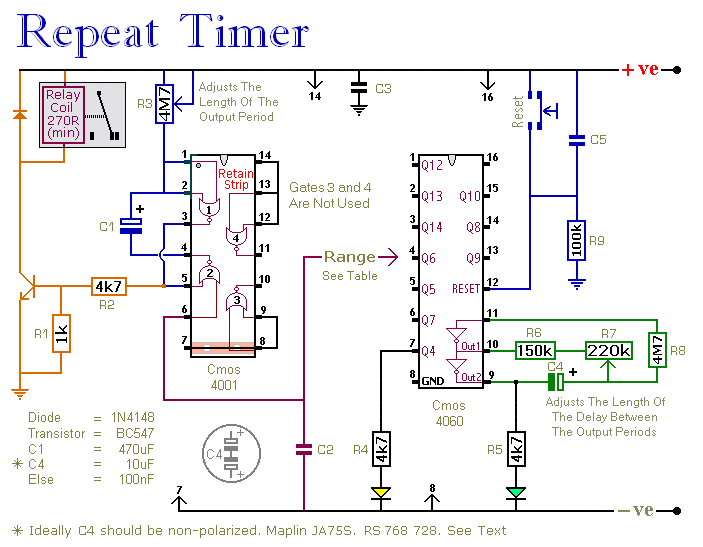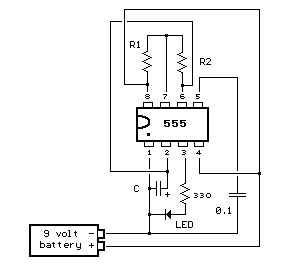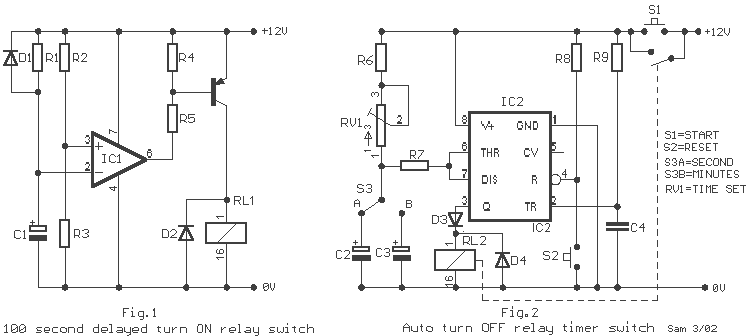
a regularly repeating interval timer

This circuit features an adjustable output timer capable of re-triggering at specified intervals. The output duration can range from a fraction of a second to over half an hour, and it can be configured to repeat at regular intervals spanning from seconds to days and beyond.
The adjustable output timer circuit typically employs a combination of a timer IC, such as the 555 timer, and various passive components like resistors and capacitors to define the timing characteristics. The configuration can be set in either monostable or astable mode, depending on the desired operation.
In the monostable mode, the circuit generates a single output pulse when triggered, with the width of the pulse determined by the resistor-capacitor (RC) time constant. The output period can be adjusted by changing the values of the resistor and capacitor. For longer durations, larger capacitance values and higher resistance values are used.
In the astable mode, the circuit continuously oscillates between high and low states, producing a square wave output. The frequency of oscillation and duty cycle can be adjusted by modifying the resistors and capacitors in the feedback loop. This mode is useful for applications requiring regular intervals of output without the need for a trigger signal.
To enhance functionality, additional components such as diodes may be included to prevent reverse polarity or to shape the output signal. Furthermore, integrating a microcontroller can provide more sophisticated timing control and programmability, allowing for complex timing sequences and user interfaces.
Overall, this adjustable output timer circuit is versatile and can be adapted for various applications, including automation systems, time delay relays, and periodic signal generation. Proper selection of components and configuration is crucial to meet the specific timing requirements of the intended application.This circuit has an adjustable output timer that will re-trigger at regular intervals. The output period can be anything from a fraction of a second to half-an-hour or more - and it can be made to recur at regular intervals of anything from seconds to days and beyond.. 🔗 External reference
The adjustable output timer circuit typically employs a combination of a timer IC, such as the 555 timer, and various passive components like resistors and capacitors to define the timing characteristics. The configuration can be set in either monostable or astable mode, depending on the desired operation.
In the monostable mode, the circuit generates a single output pulse when triggered, with the width of the pulse determined by the resistor-capacitor (RC) time constant. The output period can be adjusted by changing the values of the resistor and capacitor. For longer durations, larger capacitance values and higher resistance values are used.
In the astable mode, the circuit continuously oscillates between high and low states, producing a square wave output. The frequency of oscillation and duty cycle can be adjusted by modifying the resistors and capacitors in the feedback loop. This mode is useful for applications requiring regular intervals of output without the need for a trigger signal.
To enhance functionality, additional components such as diodes may be included to prevent reverse polarity or to shape the output signal. Furthermore, integrating a microcontroller can provide more sophisticated timing control and programmability, allowing for complex timing sequences and user interfaces.
Overall, this adjustable output timer circuit is versatile and can be adapted for various applications, including automation systems, time delay relays, and periodic signal generation. Proper selection of components and configuration is crucial to meet the specific timing requirements of the intended application.This circuit has an adjustable output timer that will re-trigger at regular intervals. The output period can be anything from a fraction of a second to half-an-hour or more - and it can be made to recur at regular intervals of anything from seconds to days and beyond.. 🔗 External reference





